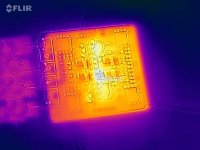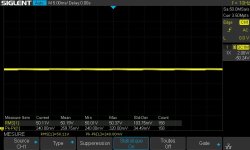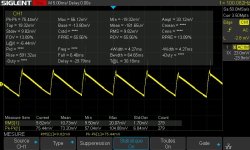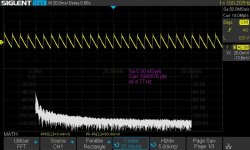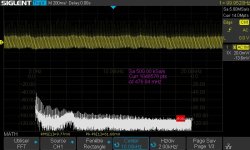iTiberius,
is there any advantage of the +/-20v Saligny Universal over the +/-40V version in terms of quality? Thinking of trying one and the 40v version could be more "universal" for my applications.
S
is there any advantage of the +/-20v Saligny Universal over the +/-40V version in terms of quality? Thinking of trying one and the 40v version could be more "universal" for my applications.
S
S,
The difference is in mosfet Rdson. At low voltage is easy to source mosfet with very low Rdson, even under 1mohm. Lower Rdson is translated in lower EMI, better current capability, lower power loss, lower noise and overall better audio performance.
For the time been only Saligny Universal at max. +/-40Vdc is available.
Universal @ +/-55Vdc is in production and will be available by the end of May.
The difference is in mosfet Rdson. At low voltage is easy to source mosfet with very low Rdson, even under 1mohm. Lower Rdson is translated in lower EMI, better current capability, lower power loss, lower noise and overall better audio performance.
For the time been only Saligny Universal at max. +/-40Vdc is available.
Universal @ +/-55Vdc is in production and will be available by the end of May.
@viltsone
Saligny Power GaN can be preordered by mail and in few days from webshop.
There will be two versions:
1. Up to 90Vdc output or symmetric +/-45Vdc at 150A.
2. Up to 180Vdc output or symmetric +/-90Vdc at 50A.
https://www.diyaudio.com/community/...ier-in-the-world-probably.397641/post-7354058
Saligny Power GaN can be preordered by mail and in few days from webshop.
There will be two versions:
1. Up to 90Vdc output or symmetric +/-45Vdc at 150A.
2. Up to 180Vdc output or symmetric +/-90Vdc at 50A.
https://www.diyaudio.com/community/...ier-in-the-world-probably.397641/post-7354058
Hello,
I made some measurements of the Saligny Universal bridges mounted on a board that I developed for Class B amplifiers.
The power supply outputs 50Vdc with 1.5K Ohms resistor load.
Stef.
I made some measurements of the Saligny Universal bridges mounted on a board that I developed for Class B amplifiers.
The power supply outputs 50Vdc with 1.5K Ohms resistor load.
Stef.
Attachments
Hi All,
I'am trying to find some reviews from Evotronix products in order to get some judgement about the advantages from these rectifiers regarding the sound qualtity compared to 'norma' diodes.
Has someone made comparisons?
These active rectifiers are quit an investment.
Thank you, regards Jan
I'am trying to find some reviews from Evotronix products in order to get some judgement about the advantages from these rectifiers regarding the sound qualtity compared to 'norma' diodes.
Has someone made comparisons?
These active rectifiers are quit an investment.
Thank you, regards Jan
JanDH,
I compared the Saligny Power (SP) to regular square bridge rectifier in ZM’s singing bush…the SP may have added a bit speedier/ clearer delivery in the upper frequencies….Psychoacoustic? I did not run any measurements. Switching between both, no noise was evident.
I went with the SP. I do like the mounting aspect. Of interest, the power supply board had a mounting screw hitting a trace on the board…direct short. I finally figured it out & the SP withstood the short..twice! So it’s a tough little bugger.
Yes they are spendy in comparison.
I compared the Saligny Power (SP) to regular square bridge rectifier in ZM’s singing bush…the SP may have added a bit speedier/ clearer delivery in the upper frequencies….Psychoacoustic? I did not run any measurements. Switching between both, no noise was evident.
I went with the SP. I do like the mounting aspect. Of interest, the power supply board had a mounting screw hitting a trace on the board…direct short. I finally figured it out & the SP withstood the short..twice! So it’s a tough little bugger.
Yes they are spendy in comparison.
The Salignys are not there to change the sound of an amp. 😉
On the other hand, as it is quicker to provide energy than a classic diode bridge, this can change things for the amp.
It is mainly the technical characteristics that interest: Does not heat up (nice for class A which consumes kg of heatsink just for the diodes, nice for Classe B as fast to deliver energy). We get 1V more. Measurements also show that it is less noisy than traditional bridge diodes.
But expensive, I agree. I would have difficulty equipping all my amps with Saligny bridges.
Stef.
On the other hand, as it is quicker to provide energy than a classic diode bridge, this can change things for the amp.
It is mainly the technical characteristics that interest: Does not heat up (nice for class A which consumes kg of heatsink just for the diodes, nice for Classe B as fast to deliver energy). We get 1V more. Measurements also show that it is less noisy than traditional bridge diodes.
But expensive, I agree. I would have difficulty equipping all my amps with Saligny bridges.
Stef.
IMO, active rectification used for Class A amplification has the advantage of reducing chassis temperatures.
Sound quality is a subjective matter and is probably up to the end user to figure out.
I do use active rectification for all my amplifier projects now.
Sound quality is a subjective matter and is probably up to the end user to figure out.
I do use active rectification for all my amplifier projects now.

I use mosfet regulation in most of my power supplies (exept where I use tubes) They have a clear audible advantage in the places where I use them.
One of the most surprising spots where these have clearly audible positive effect is the power supplies of my field coil loudspeakers, imagine that! The low impedance seems to be the key factor here.
The Salingy standard is very good in this spot but I even get better results with some self built mosfet rectifiers.
In my dac and streamers I like the Salingy standard very much.
One of the most surprising spots where these have clearly audible positive effect is the power supplies of my field coil loudspeakers, imagine that! The low impedance seems to be the key factor here.
The Salingy standard is very good in this spot but I even get better results with some self built mosfet rectifiers.
In my dac and streamers I like the Salingy standard very much.
I use LT3420 based active rectifier with Super Regulator in my soundcard and the difference for me is very very huge. Without LT4320 is sound like dead and I do not want to listen music. My body literally starts to scream. Everything sounds better, more detail, better vocals, flow, liveness etc. I am not so good to describe it. I also can understand that all people do not hear or feel the difference. 🙂
I really like to test GaN power active rectifier. If I could find suitable schematic for that.
I really like to test GaN power active rectifier. If I could find suitable schematic for that.
@iTiberius us I tried to send a PM but apparently that is disabled.
I've been interested in your synchronous rectifiers before and now need a few more.
They are a unique product, very nice that you designed it for us!
I think the Saligny is what I need, should be no problem to supply 6A continuous at 12VAC in.
As the load is a tube heater through a step-down converter, the turn-on cold inrush current can be much higher, I guess that would not be a problem?
Are they in stock at your shop?
Jan
I've been interested in your synchronous rectifiers before and now need a few more.
They are a unique product, very nice that you designed it for us!
I think the Saligny is what I need, should be no problem to supply 6A continuous at 12VAC in.
As the load is a tube heater through a step-down converter, the turn-on cold inrush current can be much higher, I guess that would not be a problem?
Are they in stock at your shop?
Jan
Does anybody have an idea how to determine the required capacitance at the output of a Saligny-type active rectifier bridge?
For the 4320 I found that Cload should be Iav/(Vripple*2*50) for a 50Hz installation. Seems a lot.
@Supersurfer, what do you use?
Jan
For the 4320 I found that Cload should be Iav/(Vripple*2*50) for a 50Hz installation. Seems a lot.
@Supersurfer, what do you use?
Jan
@iTiberius
I installed a Saligny LC but I have a problem under load.
I use it to feed an LM317 and at no load I have 9,7 Vac at the rectifier input and puts out just over 13 Vdc.
When loading the 317 with 0,5A the transformer drops to 9,3 Vac and get only 9,2 Vdc out of the rectifier.
I know the LC is specified as 6-50 Vac so my 9,3 Volt should be sufficient.
To limit the heat dissipation on the LM317 (need 5 V out) I already installed 2 resistors after the recitifier for some voltage drop but when I only get 9 Vdc under load I could bypass these resistors.
My questions are:
Can the component tolerance at the LC have the 6Vac requirment being higher in real life like > 9,3 Vac ?
If this creates a dimming effect and the conductivity of the LC drops the 12 Vdc to 9 Vdc will it still have the same benefits in reducing the noise and ringing etcetera ?
If so I will bypass the resitors and be happy anyway 🙂
I installed a Saligny LC but I have a problem under load.
I use it to feed an LM317 and at no load I have 9,7 Vac at the rectifier input and puts out just over 13 Vdc.
When loading the 317 with 0,5A the transformer drops to 9,3 Vac and get only 9,2 Vdc out of the rectifier.
I know the LC is specified as 6-50 Vac so my 9,3 Volt should be sufficient.
To limit the heat dissipation on the LM317 (need 5 V out) I already installed 2 resistors after the recitifier for some voltage drop but when I only get 9 Vdc under load I could bypass these resistors.
My questions are:
Can the component tolerance at the LC have the 6Vac requirment being higher in real life like > 9,3 Vac ?
If this creates a dimming effect and the conductivity of the LC drops the 12 Vdc to 9 Vdc will it still have the same benefits in reducing the noise and ringing etcetera ?
If so I will bypass the resitors and be happy anyway 🙂
Last edited:
Are you saying that the excessive drop is with some series resistors after the rectifier?@iTiberius
I installed a Saligny LC but I have a problem under load.
I use it to feed an LM317 and at no load I have 9,7 Vac at the rectifier input and puts out just over 13 Vdc.
When loading the 317 with 0,5A the transformer drops to 9,3 Vac and get only 9,2 Vdc out of the rectifier.
I know the LC is specified as 6-50 Vac so my 9,3 Volt should be sufficient.
To limit the heat dissipation on the LM317 (need 5 V out) I already installed 2 resistors after the recitifier for some voltage drop but when I only get 9 Vdc under load I could bypass these resistors.
My questions are:
Can the component tolerance at the LC have the 6Vac requirment being higher in real life like > 9,3 Vac ?
If this creates a dimming effect and the conductivity of the LC drops the 12 Vdc to 9 Vdc will it still have the same benefits in reducing the noise and ringing etcetera ?
If so I will bypass the resistors and be happy anyway 🙂
This will undoubtedly drop the input to the LC.
You say that the transformer output drops to 9.3Vac but what matters is what the input to the LC becomes.
Your numbers indicate that the input to the LC drops to something like 6 or 6.5Vac giving you 9.2Vdc
At the 500mA load, I would guess that your series resistor is about 6 ohms?
Jan
- Home
- Group Buys
- Ideal bridge rectifier GB
